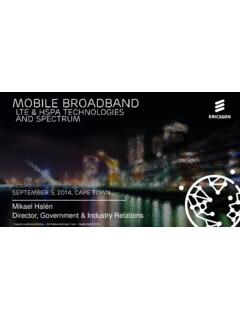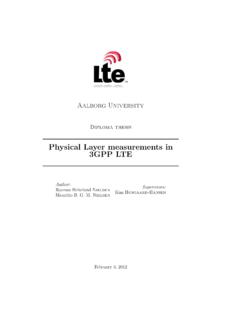Transcription of QoS /QoE in the context of videoconferencing services over ...
1 QoS /QoE in the context of videoconferencing services over LTE/4G networks. NDIAYE Maty PhD student within France Telecom / Orange Labs ETSI workshop on telecommunications quality matters 28/11/2012, Vienna (Austria) 2 Agenda part 1 Scope of the current study part 2 videoconferencing services and associated codecs part 3 LTE/4G in a nutshell part 4 Goal of the experiment part 5 Description of the experimentation part 6 IP results part 7 Summary and next step QoS /QoE in the context of videoconferencing services over LTE/4G networks. 3 Scope of the current study With the important technology advances in the area of mobile devices, the development of data traffic on current 3G mobile networks is rocketing.
2 Emergence of voice and video services , in particular video conferencing for personal and professional use over mobile devices The growth of consumer demands for multimedia services generates huge amount of video traffic on mobile networks This increase of mobile data consumption pushes operators to invest in new mobile broadband networks relying on advanced radio and IP network technologies 3 GPP has then defined a new standard LTE/4G [Release 8] integrating several quality levels to cope with these new applications and services QoS /QoE in the context of videoconferencing services over LTE/4G networks.
3 4 Videocalling services and associated codecs With LTE, more bandwidth and less latency for streaming multimedia contents some applications are very sensitive to network/radio conditions. there is a need to check that conversational services will perform efficiently with this new mobile network. To ensure the best Quality of Experience (QoE) when dealing with mobile video calls -Selection of video and audio codecs in line with the capabilities of bearers -The user expectations (low-cost, regular, premium services ) -Tradeoff between the right bitrate and the highest video and audio quality.
4 No specific media codecs are defined for these types of services over LTE : Some recommendations propose to use the existing codecs (AMR, AMR-WB (voice) and , (video) However, active works are ongoing to develop High-Efficiency Video Coding (HEVC) (video) and Enhanced Voice Service (EVS)(voice and audio). QoS /QoE in the context of videoconferencing services over LTE/4G networks. 5 LTE/4G in a nutshell Two main components: Evolved Packet Core (EPC) and e-UTRAN . Throughput expected around 100 Mbps in DL and 50 Mbps in UL Reduced latency complying with the expectations of real-time applications QoS management through bearers set-up.)
5 New radio technologies : OFDMA, SC-FDMA and MIMO. All IP architecture, relying on IMS system handling SIP protocol. Figure 1 : LTE Architecture ( ) Figure 2 : Qos managment QoS /QoE in the context of videoconferencing services over LTE/4G networks. 6 Goal of the experimentation What ? : The main target is to study the usability of existing standardized codecs when dealing with videoconferencing services over currently deployed LTE/4G networks. Where ? : Experiments were launched with the use of available LTE dongles and on the ImaginLab 4G/LTE experimental platform deployed in Brest (France) by Images and Networks French Cluster.
6 ( ) How ? : Connections were set-up using best effort mode (non-guaranteed QoS), without mobility in the present case, close to the antenna (approximately between 150-200m), within a building, using 2,6 GHz radio frequency. QoS /QoE in the context of videoconferencing services over LTE/4G networks. 7 LTE cartography (source : Images and Networks French Cluster) QoS /QoE in the context of videoconferencing services over LTE/4G networks. 8 Technical description of the experimentation Experimentation tools used : Orange Labs internally developed probe called SondeQoS : - The tool is able to set-up and tear-down videocall using the SIP protocol.
7 - Several codecs are implemented when setting-up end-to-end calls over the LTE network with several configurations ( H264 / or H263 / G711) -Different reference audio and video files can be injected within the tool so as to stream different contents (image resolution, frame per second, bitrate, ) -Several key performance metrics can be gathered at the end of each call and the outcoming audio and video files can be stored for quality inspection CIF( 320x288) resoulution 4 CIF( 704x576) resoulution 720p( 1080x720) resoulution QoS /QoE in the context of videoconferencing services over LTE/4G networks.
8 9 QoS & QoE over LTE/4G Description of the experimentation: simulation of end-to-end calls over the LTE/4G via SondeQoS probe QoS /QoE in the context of videoconferencing services over LTE/4G networks. 10 Interpretation of IP results MOS=[ ] Call registration =[ ] Call establishment=[ ] Percentage of audio lost packets= [0% ] Percentage of video lost packets= [0% ] Jitter=[0ms ] Codec flow: = 64 kbps AMR-NB = variable rate & Voice activity detection(VAD)= on (1) = 64 kbps = 2*32 kbps stereo AMR-WB = kbps & VAD =1 profile= Baseline profile Max picture rate= 625 picture s /sec QoS /QoE in the context of videoconferencing services over LTE/4G networks.
9 Configuration Parameters Call registration Call establishment ms ms ms ms ms Throughput (average) Audio UL = kbps DL = kbps Video UL = kbps DL = kbps Audio UL = kbps DL = kbps Video UL= kbps DL = kbps Audio UL = kbps DL = kbps Video UL= kbps DL = kbps Audio UL = kbps DL = kbps Video UL= kbps DL = kbps Audio UL = kbps DL = kbps Video UL = kbps DL = kbps MOS Audio UL & DL = Audio UL & DL Audio UL = DL = Audio UL = DL = Audio UL = DL = Jitter (average)
10 Audio UL = ms DL = ms Video UL = ms DL= ms Audio UL = ms DL = ms Video UL = ms DL= ms Audio UL = ms DL = 0 ms Video UL = ms DL= ms Audio UL = ms DL = ms Video UL = ms DL= ms Audio UL = ms DL = ms Video UL = ms DL= ms Percentage of lost packets Audio UL = DL = Video UL = DL = Audio UL = DL = 0% Video UL = DL =0% Audio UL = DL = 0% Video UL = DL =0% Audio UL = 0% DL = Video UL = 0% DL = Audio UL = DL = 0% Video UL = DL =0% 11 Interpretation of IP results MOS=[ ] Call registration =[ ] Call establishment=[ ] Percentage of audio lost packets= [0% ] Percentage of video lost packets= [0% ] Jitter=[0ms ] Codec flow: = 64 kbps AMR-NB = variable rate & Voice activity detection(VAD)= on (1) = 64 kbps = kbps stereo AMR-WB = kbps & VAD =1 profile= Baseline profile Level= level 2 Max picture rate= 625 pictures /sec QoS /QoE in the context of videoconferencing services over LTE/4G networks.










